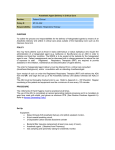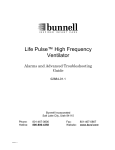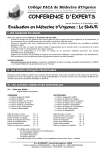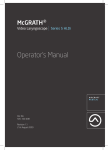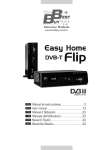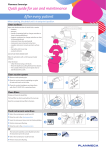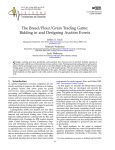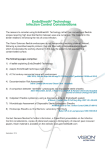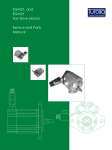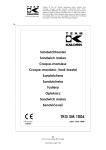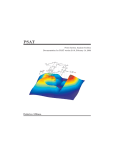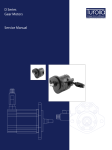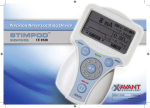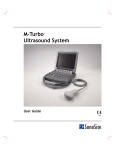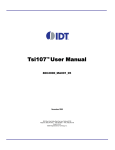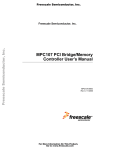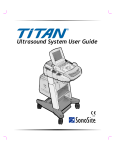Download OpMan PATe ENG_v3 SC rev 2
Transcript
User’s Manual KALAS Medical, s.r.o. Slovenských partizánov 1130/50,P.O.BOX 48/A 017 01 Považská Bystrica SLOVAKIA Page 1 tel: fax: E-mail: Web: 00421 42 4326907, 4325104 00421 42 4326907 [email protected]; [email protected] www.kalas.sk © 2008 Kalas Medical OB1 This technical appliance will reliably serve its purpose only if used in accordance with this User’s manual. All guaranties related to the machine provided by the company Kalas Medical Ltd. will be void if the appliance shall not be used and maintained in accordance with this User’s manual. The appliance can be used only by qualified and trained personnel that have carefully studied and considered this User’s manual, warnings on the appliance or corresponding documentation and followed all specified guidelines and instructions. If this machine is not operating as specified in this User’s manual, we do not recommend its usage. Operating personnel are responsible for all injuries or harm to health resulting from the incorrect use, unauthorised repairs, damage or non-adequate maintenance performed by other than Kalas Medical Ltd. personnel or contractual representatives of KALAS Medical Ltd. Považská Bystrica, Slovakia. If you need any advice, explanation or any additional information about the appliance, please contact the commercial representative, or the producer. Page 2 © 2008 Kalas Medical WARNING: Defects of the appliance caused by non-professional use, or not following the guidelines and instructions mentioned in this User’s manual, will not be admitted for claim and warranty repair. The producer is not responsible for damages caused by carelessness. The producer reserves the right to make changes to the appliance that will not considerably affect the characteristics of the machine. Page 3 © 2008 Kalas Medical Summary 1. 2. 3. Characteristics and technical specification of the appliance.......................... 5 Safety instruction........................................................................................................ 6 Supplied equipment ................................................................................................. 7 3.1. Basic equipment .................................................................................................... 7 3.2. Accessory equipment – as per separate order ................................................ 8 4. Description of the appliance................................................................................... 8 5. Usage of ventilator .................................................................................................. 10 5.1. Switching ON / OFF the ventilator ..................................................................... 10 5.2. Feeding by external adapter from external power supply ........................... 10 5.3. Reserve power supply - batteries ...................................................................... 11 5.4. Pneumatic – manual mode ............................................................................... 11 5.5. Set up / assembling of the ventilator ................................................................ 12 5.6. Disassembling of ventilator ................................................................................. 14 6. Cleaning and sterilization of ventilator.................................................................... 14 7. Process of starting ventilation ................................................................................... 15 7.1. Control of functions ............................................................................................. 15 7.2. Setting of the ventilator....................................................................................... 16 8. Special modes of ventilation .................................................................................... 18 8.1. Deepened ventilation (Ventilation during spontaneous breathing)........... 18 8.2. Cleaning of airways / Tracheo-bronchial Toilette .......................................... 18 8.3. Inpulsion mode ..................................................................................................... 18 8.4. Expulsion mode .................................................................................................... 18 8.5. Long term ventilation........................................................................................... 19 9. Most common problems............................................................................................ 20 10. HFJV COOKBOOK - Quick guide of OB 1 Paravent parameters set-up .......... 22 10.1. Set-up of basic parameters.............................................................................. 22 10.2. Determination of MV (minute ventilation) and Vt (tidal volume) .............. 23 10.3. Overview for a quick orientation..................................................................... 28 10.4. Applications of HFJV providing for transitional / clear airways .................. 28 10.5. Less standard situations..................................................................................... 28 10.6. Non-standard situations .................................................................................... 29 10.7. Non-invasive HFJV-M (HFJV by Mask)............................................................. 30 10.8. HFJV in Magnetic Resonance.......................................................................... 30 10.9. Special applications with the use of Expulsion effect / mode ................... 30 10.10. Special applications in tracheo-bronchial surgery .................................... 32 10.11. Special applications in otolaryngologic surgery......................................... 32 Page 4 © 2008 Kalas Medical 1. Characteristics and technical specification of the appliance The OB1 Paravent PATe is an electronically-controlled high frequency jet ventilator with changeable frequency of 20, 40, 120, 180 c/min (switch FREQUENCY - position A.1) optional time ratio inspiration time / expiration time 1:2, 1:1 and 2:1 (switch TIME RATIO - position A.2) and adjustable insufflation pressure 0 - 300 kPa (switch INSUF. PRESS. – position A.11) which is monitored (position A.4). The insufflation pressure varies with the change of insufflation nozzles of the multi-nozzle jet injector (MNJI) to ventilating pressure levels according to the chosen nozzle independently of the size of MNJI used. Ventilated pressure is monitored on the manometer (position E.1) on the top cover of the machine either in the whole breathing cycle (frequency of 20, 40 c/min) or its peak pressure at the end of inspiration (frequency of 120, 180 c/min). Supply pressure 400 kPa ± 100 kPa Flow of source of pressure min. 50 l/min. Power supply A. 12V DC 100mA - for mains feed external adapter 230V AC / 12V DC (SZ 12/2/100) B. Reserve - 4x NiMH battery size AA (ensures not less than 8 working hours when fully charged) C. pneumatic Frequency optional : Time ratio Ti : Te optional : 1:2, 1:1, 2:1 ±5% (if 2:1 and 120 or 180 c/min active, the expiration jet is turned on) Change of insufflation pressure 0 – 300 kPa / min.; monitored by pressure gauge on front panel Max.ventilation power according to insufflation pressure For insufflation pressure 160 kPa - dýza č.I - nozzle n.I max. 2.5 kPa - nozzle n. II max. 4.5 kPa - nozzle n. III max. 7.0 kPa -expiration nozzle max. 4.0 kPa Pressure limit Pressure gauge of ventilation Dimensions W, H, L 20, 40, 120, 180 c/min ± 5 % max. 2.5 kPa fixed : 5 kPa ± 5 % (static), max. reaction time 120 ms A. Whole process of breathing cycle (PAW) for frequencies 20 and 40 c/min. B. The highest pressure at the end of inspiration (PIP) for frequency of 120 and 180 c/min 235 x 100 x 250 mm Page 5 © 2008 Kalas Medical Weight 4.3 kg Noise Level max. 74 dB Working conditions temperature humidity –10 °C to + 40 °C max. 80 % Classification 1. Type of protection against electricity accident: a) external adapter 230V AC / 12V DC (SZ 12/2/100 from Enco) is class II b) when mains feeding by external adapter 230V AC / 12V DC (SZ 12/2/100 from Enco) the whole machine is class II B as per ČSN EN 60601-1 c) when using NiMH batteries as a reserve power supply, the machine is using the internal power supply 2. Level of protection against electricity accident : machine is type B as per ČSN EN 60601-1 3. Level of protection against harmful penetration of water: External adapter 230V AC / 12V DC (SZ 12/2/100 from Enco) and the machine itself are protected against leaking water (IPX1) as per ČSN EN 60601-1 4. Working mode : machine can be used in permanent operation 5. Protection against the danger of inflammation of flammable anaesthetic mixtures : The machine must not be used in environment where are flammable anaesthetic mixtures as per ČSN EN 60601-1. For ventilation in the field or during transportation, a source of compressed oxygen (pressure cylinder with the capacity 2, 5, or 10 L) equipped with a cylinder pressure regulator with a quick coupler which is set up to outlet overpressure 400 kPa ± 100 kPa is required. 2. Safety instruction • • • • • This user’s manual is an inseparable part of the appliance. Before using the appliance read carefully this manual. Respect all warnings. Follow the instructions. Service and reparation of the appliance can be executed only by authorized persons. Original replacement parts must be used while repairing. If original replacement parts are not used the appliance can be damaged and its correct operation cannot be ensured. Page 6 © 2008 Kalas Medical 3. Supplied equipment 3.1. Basic equipment Make sure the packing includes following equipment: Ordering Number No. of units PVF 046 2x PVF 075-068 set 3x one-way valve for ventilating with pure oxygen FiO2 ≅ 0,95 PVF 031.1 5x set of extensions for ventilation with the mask (size 5, 8, 10) (reduction: MNJI5-mask ; MNJI8-mask; MNJI0-mask) PVF 031.2 5x T- set for expulsion mode PVF 035 1x external adapter 230V AC / 12V DC MES30AMED 1x recharge cable for emergency vehicles PVK 047 1x - 1x - - 1x - - 1x - Spare part Set of catheters PATe (length cca 1,5m , standard set 3pcs of cathethers) set of MNJIs (multi-nozzle jet injector) (8 tprm MNJI 3; 4; 5; 6; 7; 8; 9; 0 set ) back-up power reserve ( 4 pcs NiMH type AA ) NiMH battery charger for recharging backup reserve user’s manual Page 7 PHOTO © 2008 Kalas Medical 3.2. Accessory equipment – as per separate order As per the specifications of customer extensions for rigid bronchoscope Set of adjusted catheters (lenght 10m, set of 2pcs of catheters from non-magnetic material) Spare insufflation valve - PVF 046.1 PVF 018 4. Description of the appliance A. Front panel Page 8 © 2008 Kalas Medical B. Rear panel A) Front panel 1. Switch for adjustment of FREQUENCY 2. Switch for adjustment of TIME RATIO of inspiration and expiration 3. Switch for manual / pneumatic ventilation 4. Manometer / gauge of insufflation pressure 5. Luminous LED indicator of batteries 6. Luminous LED indicator for connection of the appliance to mains supply 7. Luminous LED indicator for alarm 8. Inspiration valve 9. Slot for measuring catheter 10. Expiration valve 11. Switch for adjustment of insufflation pressure B) Rear panel 12. Valve for connection of oxygen hose 13. Battery compartment 14. Slot for external adapter 15. Switch for switch ON / OFF of the appliance C) Multi nozzle jet injector 1. Inspiration nozzles n. I, II a III 2. Expiration nozzle 3. Measuring nozzle 4. Connection for ET cannula or for mask connection by mask’s extension 5. Connection for T – piece Page 9 © 2008 Kalas Medical D) Set of catheters 1. Inspiration catheter – color: red 2. Expiration catheter – color: green 3. Measuring catheter 4. LUER cone of inspiration catheter 5. LUER cone of expiration catheter 6. RECORD cone of measuring catheter E) Top cover 1. Manometer / gauge for the Paw pressure 5. Usage of ventilator 5.1. Switching ON / OFF the ventilator To switch ON the ventilator put the switch for switch ON / OFF n. B.15 into the position ๏. To switch OFF the ventilator put the switch for switch ON / OFF n. B.15 into the position O. 5.2. Feeding by external adapter from external power supply Electrical supply of the appliance is through the external adapter 220 V AC / 12 V DC. Plug the external adapter 12 V DC to the external power supply. The green LED on the adapter will light up. Plug the connector of external adapter to the slot (position B.14) on the appliance. On the front panel the green LED (position A.6) will light up to indicate external power supply. In this case the power supply is the electrical network even if the batteries are placed in the battery compartment. It is possible to keep the external adapter plugged into external power supply for maintenance of NiMH battery capacity if they are placed in the battery compartment. This state is indicated by green LED in field BATT. (position A.6). Using any other adapter than the one supplied by the manufacturer of the product is not recommended. Page 10 © 2008 Kalas Medical 5.3. Reserve power supply - batteries Electrical Reserve is provided by four NiMH batteries of size AA (position B.13). When fully charged, the reserve enables the ventilator to operate for at least 8 hours. The basic equipment of the ventilator includes AA sized, NiMH battery charger to be used to keep the reserve in optimum state (the battery charger manual is enclosed in its package). The capacity of batteries plugged in the ventilator is maintained against self-discharging by a small electric current as long as the ventilator is plugged to external power supply unit. This state is indicated by green LED in field BATT. (position A.5). Regular “dry” or alkaline batteries of size AA are not to be used as reserve. NiCd or NiMH batteries of size AA with the capacity at least 500mAh must be used. Place charged batteries into the slot marked as BATTERIES (position B.13) in the way it is indicated on the top of the slot. If the ventilator is not connected to the external power supply by the adapter, the green LED will come on (position A.6) when the batteries are charged. If the red LED (position A.5) comes on the batteries are not sufficiently charged and it is necessary to charge them according to the user’s manual in enclosed charger. NiMH batteries need to be kept in a good condition with help of a charger from the basic equipment as written in the enclosed manual of the charger. Once a month have the batteries recharged in the charger using the discharging mode. The period of usage recommended by the ventilator manufacturer is 2 years. New spare NiMH batteries can be bought from the manufacturer, or their authorised agent. If the reserve is unplugged from the machine, this is indicated (with the ventilator plugged into the mains feed and turned on) by red LED (position A.5) in the field BATT. Lower voltage of back-up power reserve is indicated by red flashing LED (position A.5) in the field BATT once in two seconds when the machine is plugged to mains feed and in case of running the ventilator from the reserve it is also indicated by the acoustic alarm (0.5 second long beep 1x in 10 seconds). Insufficient voltage of back-up power reserve is indicated by red flashing LED (position A.5) in the field BATT twice in a second when the machine is plugged to mains feed and in case of running the ventilator from the reserve it is also indicated by an acoustic alarm (2x in a second together with visual alarm) and by stopping the machine. In this case, the manual controls of inspiration and expiration time by the switch MANUAL can be used (position A.3). 5.4. Pneumatic – manual mode If necessary it is possible to use manual operation of inspiration and expiration time by switch MANUAL (position A.3). By pushing this switch you define the time of the inspiration and while it’s released the expiration is proceeding. Repeat the manual ventilation as needed. In pneumatic / manual mode it is imperative the ventilator is connected to the oxygen or compressed air source. Page 11 © 2008 Kalas Medical 5.5. Set up / assembling of the ventilator A.) Valve connection: 1) Plug inspiration insufflation valve to the slot marked INSP in red field (position A.8) and secure it by tightening safety bolts 2) Plug expiration insufflation valve to the slot marked EXP in green field (position A.10) and secure it by tightening safety bolts These valves are not exchangeable. In the case of exchange of bolts, these can’t be fastened, which prevents the exchange and ensures the proper fit of valves and proper function of the appliance. When unpacking the ventilator from original pack the inspiration and expiration valves are already installed. B.) Connection of set of catheters to ventilator : 1) Connect inspiration insufflation catheter to inspiration insufflation valve (red to red) by quick coupler marked red (n. D.1 to position A.8). The Inspiration insufflation catheter ends by cone LUER and lavage valve. 2) Then connect expiration insufflation catheter to expiration insufflation valve (green to green) by quick coupler marked green (n. D.2 to position A.10). The Expiration insufflation catheter ends by curved connector with cone LUER. 3) Connect measuring catheter to connector marked MEAS. CATH. (n. D.3 to position A.3) by quick coupler marked grey. The measuring catheter ends with a connector RECORD The exchange of connections of catheters to insufflation valves is not possible. C.) Connection of set of catheters to MNJI : 1) Choose MNJI by the number which symbolises the diameter of its cylindrical cavity (tolerance +-0.5mm) for pre-chosen endo-tracheal tube with the same diameter (e.g. for tracheal tube 3,5 - MNJI No. 3 or 4) and measuring connector of the same size. 2) Using LUER cone, connect inspiration insufflation catheter with lavage valve to the hole of inspiration nozzle of chosen MNJI marked by roman number I (n. D.4 to C.1). While choosing the size of inspiration nozzle, see also the Cookbook OB1 Paravent PATe. 3) Expiration insufflation catheter with curved connector LUER is to be connected to the hole of expiration nozzle of MNJI (n. D.5 to C.2) (see picture n. 1). 4) Connect measuring catheter by RECORD cone to the hole of measuring connector (n. D.6 to C.3) (see pic. 1). Page 12 © 2008 Kalas Medical Picture n. 1 - Connection of set of catheters to MNJI D.) Connection of MNJI to the mask: 1) To the connection n. C.4 of the MNJI connected to set of catheters as described in part 5.5.C.), connect the extension / reduction for the ventilation with mask. The size of the extension / reduction must fit with the size of mask (see picture n. 2). 2) Connect the mask to the extension / reduction (see picture n. 2). Picture n.2 – Connection of MNJI to the mask E.) Connection of ventilator to the source of oxygen / compressed air : Connect the ventilator by quick coupler on the oxygen hose (position B.12) to the source of oxygen or compressed air (central distribution or oxygen bottle with reduction and quick coupler). Page 13 © 2008 Kalas Medical 5.6. Disassembling of ventilator After finishing ventilation and the ventilator is disconnected from the compressed oxygen: 1) Disconnect inspiration insufflation catheter by quick coupler (n. D.1 from position A.8) 2) Disconnect expiration insufflation catheter by quick coupler (n. D.2 from position A.10) 3) Disconnect measuring catheter by quick coupler (n. D.1 from position A.9) 4) Unscrew nuts to release and pull out insufflation valves (position A.8 and A.10) for their sterilization 5) It is possible to leave external adapter permanently connected to the machine to conserve charged NiMH batteries that are kept in the ventilator this mode is indicated by a green LED lit on in the BATT field (position A.6). See the part 5.3. 6. Cleaning and sterilization of ventilator MNJI's, one-way valves and T pieces are packaged in an ISO certified sterile environment, and remain sterile until opened. These pieces cannot be re-sterilised once open, and are designed for single-patient usage only, as re-sterilisation may alter the physical properties and thus have an effect on airflow through the device. Possible modes of cleaning and sterilization of individual parts of ventilator: - insufflation valves - steam sterilisation at the temperature of 120o C, number of sterilization cycles is set by the durability of material - the set of catheters - ethylenoxid sterilisation, number of sterilization cycles is set by the durability of material (min. 50-times) - after the usage of lavage valve, it is necessary to disassemble and disinfect the lavage valve, clean it with an antivirus active cleaner, wash it in distilled water and dry it before proceeding the sterilisation - set of extensions for ventilation with the face mask – made for one time use only - the set of extensions for rigid bronchoscope - ethylenoxid sterilisation, number of sterilization cycles is set by the durability of material (min. 50-times) - MNJI, one way valve, T set – single patient use only; attempts to sterilise may compromise the physical shape and therefore resulting flow of air through the MNJI, and is not safe - cover of ventilator - can be cleaned using any possible cleaner with the exception of abrasive ones. In case of staining the cover with biological material (e.g. blood, etc.) disinfect it by use of an antivirus active cleaner. Page 14 © 2008 Kalas Medical 7. Process of starting ventilation 7.1. Control of functions 1) Set up the ventilator as described in section 5.5. 2) Set the required insufflation pressure by turning the insufflation pressure switch (position A.11). The actual value is monitored and shown on the manometer (position A.4). 3) Switch on the ventilator (part 5.1.) This activates the ventilator and checks its ability to work including the check of reserve power supply. It is accompanied by 3x the sound of the acoustic alarm and flash of visual alarms. After this, the machine will start working. This can be recognised by frequent exhaust from the cone LUER of inspiration insufflation catheter in frequency chosen on the switch FREQUENCY. Time ratio of Ti / Te is given by the switch TIME RATIO. The expiration insufflation valve is automatically activated when the TIME RATIO is 2:1 and the Frequency is either 120 or 180 c/min. This can be recognised by frequent exhaust from the LUER cone of curved connector of expiration insufflation catheter. At this time the operating personnel should check the amount of oxygen in the pressure bottle which cannot be less than 12 Mpa. Control of the peak pressure (pressure limit): 1) Choose MNJI n.3 2) Connect the inspiration insufflation catheter with lavage valve through LUER cone into the hole of inspiration nozzle marked by the roman number III (n.D.4 to C.1) 3) Connect the expiration insufflation catheter with the curved connector LUER to the hole of expiration nozzle of MNJI (n.D.5 to C.2) 4) Connect the measuring catheter through RECORD cone into the hole of measuring catheter of MNJI (n.D.6 to C.3) 5) Connect the ventilator to the source of oxygen / compressed air 6) Set the insufflation pressure to cca 90 kPa (position A.11) 7) Set the frequency of ventilation to 40 c/min (position A.1) 8) Switch on the ventilator (part 5.1.) 9) Close the distal end of MNJI and slowly increase the insufflation pressure up to the activation of alarm of peak pressure The output pressure of the ventilator is monitored on the manometer that is located on the top cover of the appliance. Alarm of peak pressure of the appliance is activated when the output pressure exceeds the pressure of 5 kPa ±0.5 kPa (airway pressure measured). Together with this alarm signalization, the inspiration (resp. active expiration) is disconnected up to the next breathing cycle. Page 15 © 2008 Kalas Medical 7.2. Setting of the ventilator To make high-frequency jet ventilation successful, one has to choose adequate intubation including the choice of endo-tracheal tube corresponding to age and weight of patient. 1) Connect the ventilator assembled according to the part 5.5. to the source of oxygen / compressed air and switch it on (part 5.1.). 2) Check the level of the insufflation pressure on pressure gauge on front panel (position A.4) and set its required value by switch n.A.11. 3) Set the required frequency by switch n A.1. 4) Set the required time ration by switch n. A.2. 5) Choose an MNJI by the number which symbolises the diameter of its cylindrical cavity (toleration +-0.5mm) for pre-chosen endo-tracheal tube with the same diameter (e.g. for tracheal tube 3.5 - MNJI No. 3 or 4) and measuring connector of the same size. 6) Connect distal cone ending of MNJI to endo-tracheal tube of patient (n. C.4). 7) Ventilation pressure can be seen on the gauge on the top cover of the ventilator either during the whole time (frequency 20, 40 c/min) or at its peak level at the end of inspiration (frequency 120, 180 c/min) (position E.1). 8) Check breathing movements of the breast of patient or auscultation which are the signs of working ventilator. Furthermore, you can check the level of ventilation by common clinical signs such as complexion colour, mucous colour, etc. and evaluate the sufficiency of ventilation. In case of insufficient level of ventilation (small breathing movements, lasting cyanosis, etc.) switch inspiration insufflation catheter by LUER cone from inspiration nozzle marked as number I to next inspiration nozzle marked as number II which increases the level of ventilation and check up the patient again. In case of still not having high enough level of ventilation (small breathing movements, lasting cyanosis, etc.) switch inspiration insufflation catheter by LUER cone from inspiration nozzle marked as number II to the next inspiration nozzle marked as number III which again increases the level of ventilation and check the patient again. You can fine tune the power of ventilation e.g. according to control of blood gases by changing insufflation pressure (meant as ±) by switch INSUF. PRESS. (position A.11) while checking the manometer on the top cover of the machine (position A.4). Having higher level of ventilation power may lead to higher inspiration pressures over the limit of 5 kPa which starts acoustic and visual alarm (red LED of front panel in the field ALARM – position A.7) and temporary limitation of inspiration. Using inspiration nozzle I or II, the concentration of oxygen in the mixture of inspiration gases varies from 0.5 to 0.7 depending on topical resistance of patient’s airways and amount of torn-down surrounding air. The higher the resistance of lungs, the higher the concentration of oxygen in the inspiration mixture is. To ventilate with pure oxygen, put the one-way valve on the proximal end of MNJI (position D.5) and connect the inspiration insufflation catheter to the hole of inspiration nozzle marked one number higher. The connection of one-way valve will disable to tear down the air from the surrounding atmospheric space. For this reason, during the use of the one-way valve it is highly important to keep checking the pressure gauge on the reducing valve of the pressure oxygen bottle (cannot fall below 12 Mpa) and to keep checking the functioning of ventilator. Page 16 © 2008 Kalas Medical For other setting of the ventilator see the Cookbook for OB1 Paravent PATe. Page 17 © 2008 Kalas Medical 8. Special modes of ventilation 8.1. Deepened ventilation (Ventilation during spontaneous breathing) The construction of the MNJI and the principle of high-frequency jet ventilation enables an easy and effective way of deepened ventilation even in cases when the relaxation or other lowering of spontaneous breathing activity of patient is not recommended. This is so called superposition of HFJV on spontaneous breathing, when spontaneous inspiration is discontinuely deepened by the ventilator and the work of ventilator in spontaneous expiration is discontinuely interrupted and slowed down. For this type of ventilation, it is recommended to choose the inspiration nozzle numbered I or II. For this type of ventilation, it is absolutely unacceptable to use a one-way valve. 8.2. Cleaning of airways / Tracheo-bronchial Toilette The construction of the MNJI, insufflation system including lavage valve and the principle of high-frequency jet ventilation enables drawing out from tracheobronchial areas without stopping the ventilation of the patient. In this case, the sucking catheter is plugged through the proximal end of MNJI into endo-tracheal tube and further according to the needs, at either permanent or interrupted drawing out. It is recommended to set higher ventilation power or overplacing inspiration insufflation catheter with the LUER cone in MNJI to the hole of one number higher nozzle (from I to II or from II to III) or to set higher insufflation pressure because the sucking catheter limits the ventilation power when having set higher ventilation frequencies (especially 120 and 180 c/min) for longer period of time. At the end of sucking (drawing out), you have to replace the inspiration insufflation catheter with the LUER cone to the hole of initial inspiration nozzle and possibly adjust the insufflation pressure. 8.3. Impulsion mode To lavage the airways, connect the syringe with lavage mixture to the hole in lavage valve with the cone LUER. For the instillation of the mixture into the airways choose impulsion mode with the time ratio 1:2 on the switch TIME RATIO. Push the mixture to inspiration insufflation catheter by slow, constant pressure on the injection plunger. From there it is by a pressure in inspiration insufflation catheter through the MNJI jet and by high kinetic energy of a stream of oxygen sprayed to the airways in a form of aerosol. During this operation, we recommend setting slightly higher ventilation power by increasing the insufflation pressure by about 20%. 8.4. Expulsion mode Expulsion mode is initiated by changing the I:E ratio to 2:1 on the switch TIME RATIO. In this instance with a frequency of 120 or 180 c/min, the expiration nozzle is automatically activated to limit dynamic positive end-expiratory pressure (PEEP) in the airways. In this mode, it is useful to deflate the cuff of the endo-tracheal tube to keep released phlegm from cumulating between the wall of trachea and the wall of endo-tracheal tube. Released phlegm then moves out into mouth from where it can be easily sucked out. The sucking can also be performed inside endo-tracheal tube Page 18 © 2008 Kalas Medical and airways during the ventilation. In this mode, it is not recommended to use nozzle number I because its power is not balanced with the expiration nozzle. In this mode, it is possible for the released phlegm to be splashed by expulsion effect from the proximal ending of MNJI which could contaminate surroundings. For this reason, part of accessory equipment contains a T-set that serves the purpose of elimination of possible contamination. The T piece of the T-set is to be connected by the cone F15 to the cone M15 on the proximal ending of MTG. The expiration tubing from the T-set is to be connected to the cone M22. Max. length of tubing is 1.2 m. Aerosol is captured on the walls of tube that can lead to dust-bin or can be simply covered by a sheet of linen. It is essential that the distal end of the hose is not closed. You must ensure the prevention of tube choking as this is the only way by which expiration can be realized. The T-set is a disposable material for single patient use only! 8.5. Long term ventilation Application in time periods of 1-2 hours will not cause any significant problems even without any humidification. The issue of humidification and heating of breathing mixture can be partly solved by humidification and heating of that part of breathing mixture that is torn down from the atmosphere. For this purpose, you must use the “T” piece connector. The Valve T connector serves o the purpose of isolating the part of air injected by the jet system in inspiration from expired gas mixtures from patient during expiration. This feature allows the effective set-up of the injected part of inspiration (from the point of view of humidification and oxygenation) and the elimination of contamination of the surrounding space of patient by infectious aerosol originated in such ventilation. The shoulder "A" (see pic. below) supplies atmospheric air torn down by the jet system in inspiration mode. It has an outside cone 22M. For the enhancement of humidification of breathing mixture, it is possible to connect this shoulder with a 22 mm tube to the output of humidifier. The input of humidifier is connected to the atmosphere. Further, it is possible to thin the oxygenation of the atmosphere torn-down gas mixture by the external mixer of air and oxygen. In this case it is necessary to set-up the flow of this gas mixture between 15 and 25 l/min, or alternatively including a reserve bag of volume 0.5 to 2.0 L into this branch. Such adjustments of the breathing mixture allow longer-term high-frequency jet ventilation and require relatively large experience with this type of ventilation. Therefore, for this application we recommend consultation with the producer or an expert clinical site that is knowledgeable in this topic. The shoulder "B" serves the purpose of connecting to Multi-Nozzle Jet Injector (MNJI) of the jet ventilation system. It has a inward cone 15F. This cone is connected directly to the corresponding cone 15M at the end of MNJI. Page 19 © 2008 Kalas Medical The shoulder "C" serves the purpose of removing the expired mixture from patient. It has an outward cone of 22mm. It is possible to connect it to a 22mm tube of max. length 1.2 m. The ending of tube shall be placed inside the container where the potential infectious aerosol originated in the ventilation can be captured (semisealed container). It is essential that the ending of this tube, alternatively the ending of the shoulder "C" will NOT BE CLOSED ! Valve T connector is for single-patient use only, the Supplier does not guarantee its function after the re-sterilisation! It is essential to connect the T connector as shown below so that the shoulders "A" and "C" are NOT INTERCHANGED. For the correct connection, the pointers show the direction of flow of gas through the T-set. 9. Most common problems 1) Disconnection of LUER connector on inspiration insufflation catheter from MNJI when insufficiently fixed - sudden loss of ventilation power and loud hiss and at the same time, the alarm of non-ventilation is activated. SOLUTION: adequate connection of inspiration insufflation catheter with LUER cone connection, respiration in the hole of chosen nozzle. 2) Choking of inspiration nozzle in MNJI – related mostly to MNJIs with small diameter (that is 3 and 4). It is recognized by low ventilation power mainly in the connection of insufflation catheter to the nozzle I. SOLUTION: wash out the particular inspiration nozzle of MNJI by physiological solution or by water from syringe or having changed the whole MNJI. Insertion of any metal object (metal rod, syringe needle, etc.) is NOT recomended. 3) Choking of the measuring catheter or the measuring connector – recognized through the unjustifiable disconnection or cancellation of ventilation and triggering of the alarm even when not connected to patient Page 20 © 2008 Kalas Medical SOLUTION: clean the measuring catheter and/or the measuring connector 4) With discharge of static electric current (e.g. after the physical contact by operating personnel), it is possible for the appliance after the discharge to signal some of the alarm states. After the electrical interference has ended, the alarms will stop and the appliance will function as normal. Page 21 © 2008 Kalas Medical 10. HFJV COOKBOOK - Quick guide of OB1 Paravent parameters set-up 10.1. Set-up of basic parameters In principle, the set-up of basic flow and pressure parameters is defined by the construction of the MNJI (Multi-Nozzle Jet Injector). In the case where ET (endo-tracheal) or TT (tracheostomic) cannula with adapted MNJI corresponding to patient’s weight is used, the contemplated pressure-flow parameters are pre-set by the technical construction solution of ’nozzle receiving channel’ (MNJI – ET or TT cannula) so that the requested (anticipated) level of gas exchange in lungs can be achieved. Basic Insufflation pressure is Pin = 150 ± 5% kPa. Ventilation is performed with unsealed ET or TT cannula – seal (cuff) on ET cannula is not inflated. Basic Frequency of ventilation = 120 c/min. Mean Pgmax (maximal generator pressure) for Pin = 150 kPa connected to: Nozzle I Nozzle II Nozzle III 2.0 kPa ± 20% 3.5 kPa ± 20% 5.5 kPa ± 20% This overview is applicable to all sizes of MNJI which provide comparable Ventilatory performance (it is a static pressure when the outflow-end of MNJI is closed). Pgmax (maximal generator pressure) for maximal allowable Pin = 300 kPa for all sizes of MNJI connected to: Nozzle I Nozzle II Nozzle III 4.0 kPa ±20% 7.1 kPa ± 20% 10.2 kPa ± 20% Typical course of pressure curve of MNJI no. 8 connected in nozzle II with Pin = 150 kPa (blue curve, for comparison: linear regression – black line) Page 22 © 2008 Kalas Medical Q in (l/min) MGT 8/2 -150kPa 250,00 200,00 150,00 Pin Qmax Lineární (Qmax) 100,00 50,00 0,00 0,00 0,50 1,00 1,50 2,00 2,50 3,00 3,50 4,00 Pg max (kPa) According to the medical norm, pressure higher than 10 kPa is considered destructive to lung parenchyma and shall not be used. Because the MNJI is constructed in such a way that it can generate the maximal static pressure Pgmax = 10 kPa, it follows from the physical principle that in open system of uncuffed ET cannula the pressure limit (Pt) of 10 kPa cannot be exceeded (Pt – tracheal pressure measured in dynamic mode on experimental animals was for Pin = 300 kPa in the range 7 – 8.5 kPa, that can be considered as safe from the point of view of barotrauma). Furthermore, Pin over 250-280 kPa is strongly discouraged. The second degree of protection is “total stop”, i.e. pressure guarding and limiting by the ventilator. 10.2. Determination of MV (minute ventilation) and Vt (tidal volume) For the determination of MV (minute ventilation) and Vt (tidal volume) based on frequency and other parameters, please use the attached Brychta’s Ventilation Equation: Ventilation equation.xls Model of tidal volume Vt / minute ventilation MV in HFJV: 1. In HFJV applications, the un-cuffed ET cannula normally used has a different (i.e. smaller) diameter from the diameter of the trachea; this constitutes a space for gas leakage during inspiration (mainly) as well as during expiration. This space also creates a certain small resistance (Ru) for leaking gas. In smaller patients (children, newborns), the leakage is smaller considering the anatomy of trachea and it’s mucous. 2. If the MNJI together with a constant pressure generator connected to circuit load (lungs) constitute the source of exponentially digressive flow, then a generated volume VTg is the integral of flow (Qg) in time Ti. Page 23 © 2008 Kalas Medical 3. A part of the volume generated by MNJI is leaking through Ru (leakage) into the atmosphere and so is VTd delivered into lungs lower than VTg. 4. Multi-nozzle jet injectors (MNJI) are designed and constructed with a large reserve and principally constitute the pressure generators capable to compensate for large leakage, whereas Pg (generator pressure) is not decreasing. 5. The resulting volume flowing into lungs is thus dependent on the mechanical properties of lungs (Raw and Cst) (Therefore, HFJV is contraindicated in the cases of high resistance, e.g. severe asthma). Pin MNJI Qg, Pg max, VTg ET tube Cuff deflated Leakage ( X% from VTg) VT delivered to lung Pneumatic model of lungs (per ISO norm) for individual size categories (defined by the flow of ET cannula) in Tab.1: Model C C (l/kPa) 50 25 10 3 1 0.50 0.25 0.10 0.03 0.01 R Rt Rsum (kPa/l/s) (kPa/l/s) (kPa/l/s) 0.20 0.35 1.00 5.00 10.00 0.4 0.5 1.0 2.0 2.7 0.6 0.85 2.0 7.0 12.7 Q (i/e) (l/s) Tau (sek) ETCannula (mm) 2.00 1.00 0.50 0.075 0.05 0.300 0.212 0.200 0.210 0.127 8-9 6-7 5 3-4 2.5 Using this model, calculation of VT generation was realized at a frequency 120 c/min. and an insufflation pressure Pin = 140 -150 kPa with the use of corresponding MNJI to ET cannula (3 – 9 mm) on nozzle no. II with Ti:Te = 1:1. Orientation average values of VTg for the application of MNJI from 3 to 9 in corresponding models listed in Tab.1 are listed in Tab.2: ET-Cannula (mm) VTg with Pg=3.3 kPa 8-9 6-7 5 0.334 0.276 0.110 Page 24 © 2008 Kalas Medical 3-4 2.5 0.033 0.018 During the application of HFJV with uncuffed cannula there may be leakage along ET cannula, with decreased VT delivered into lungs. After the correction for leakage, VTd and MV is roughly as follows in Tab.3: ET-Cannula (mm) Leakage % VT delivered with leakage MV with leakage calculated 8-9 6-7 5 3-4 2.5 45 40 35 30 20 0.183 0.166 0.071 0.023 0.014 22.06 19.92 8.58 2.82 1.79 Minute ventilation (MV) calculated for f = 120 b/min is in comparison to the measured MV in “normal” lungs (Cst and Raw) within the range of cca ± 20%. This calculation is only orientational, because the parameters of patient lung mechanics can significantly influence the gas exchange, whereas the correction of required energy (Pin), while monitoring Paw, and the clinical indications of patient are always determined by the healthcare practitioner. Page 25 © 2008 Kalas Medical Orientational values of Minute Ventilation and Tidal Volume for corresponding MNJI with adjusted insufflation pressure (Pin) The tables below show measured values of MV and Vt with and without leakage for corresponding MNJI on the nozzle II, with frequency 120 bpm, Ti:Te = 1:1, for adjusted Pin (range 100 – 300 kPa) measured on a laboratory measuring device with the accuracy of measurement ±1.5 % on “normal” lungs (in terms of Cst and Raw) intubated with appropriate endo-tracheal tube with uncuffed seal (with normal leakage around the cuff): MNJI Pin (kPa) Pgmax (kPa) Qgmax (L) VT max (L) VT actual w/o leakage VT actual with leakage MV actual with leakage 3 / Nozzle II 100 150 2.55 3.70 14.00 18.00 0.06 0.08 0.02 0.03 0.01 0.02 1.56 2.00 200 4.80 21.00 0.09 0.04 0.02 2.33 300 7.30 25.00 0.10 0.04 0.02 2.78 MNJI Pin (kPa) Pgmax (kPa) Qgmax (L) VT max (L) VT actual w/o leakage VT actual with leakage MV actual with leakage 4 / Nozzle II 100 150 2.55 3.70 38.00 45.00 0.16 0.19 0.06 0.08 0.04 0.04 4.22 5.00 200 4.80 53.00 0.22 0.09 0.05 5.89 300 7.30 62.00 0.26 0.10 0.06 6.89 MNJI Pin (kPa) Pgmax (kPa) Qgmax (L) VT max (L) VT actual w/o leakage VT actual with leakage MV actual with leakage 5 / Nozzle II 100 150 2.55 3.70 46.00 56.00 0.19 0.23 0.08 0.09 0.04 0.05 5.11 6.22 200 4.80 67.00 0.28 0.11 0.06 7.44 300 7.30 78.00 0.33 0.13 0.07 8.67 MNJI Pin (kPa) Pgmax (kPa) Qgmax (L) VT max (L) VT actual w/o leakage VT actual with leakage MV actual with leakage 6 / Nozzle II 100 150 2.55 3.70 84.00 101.00 0.35 0.42 0.14 0.17 0.08 0.09 9.33 11.22 200 4.80 117.00 0.49 0.20 0.11 13.00 300 7.30 143.00 0.60 0.24 0.13 15.89 Page 26 © 2008 Kalas Medical MNJI Pin (kPa) Pgmax (kPa) Qgmax (L) VT max (L) VT actual w/o leakage VT actual with leakage MV actual with leakage 7 / Nozzle II 100 150 2.55 3.70 119.00 147.00 0.50 0.61 0.20 0.25 0.11 0.14 13.22 16.33 200 4.80 173.00 0.72 0.29 0.16 19.22 300 7.30 211.00 0.88 0.35 0.20 23.44 MNJI Pin (kPa) Pgmax (kPa) Qgmax (L) VT max (L) VT actual w/o leakage VT actual with leakage MV actual with leakage 8 / Nozzle II 100 150 2.55 3.70 155.00 193.00 0.65 0.80 0.26 0.32 0.14 0.18 17.22 21.44 200 4.80 225.00 0.94 0.38 0.21 25.00 300 7.30 277.00 1.15 0.46 0.26 30.78 MNJI Pin (kPa) Pgmax (kPa) Qgmax (L) VT max (L) VT actual w/o leakage VT actual with leakage MV actual with leakage 9 / Nozzle II 100 150 2.55 3.70 183.00 193.00 0.76 0.80 0.31 0.32 0.17 0.18 20.33 21.44 200 4.80 236.00 0.98 0.39 0.22 26.22 300 7.30 283.00 1.18 0.47 0.26 31.44 MNJI Pin (kPa) Pgmax (kPa) Qgmax (L) VT max (L) VT actual w/o leakage VT actual with leakage MV actual with leakage 10 / Nozzle II 100 150 2.55 3.70 199.00 208.00 0.83 0.87 0.33 0.35 0.18 0.19 22.11 23.11 200 4.80 245.00 1.02 0.41 0.23 27.22 300 7.30 320.00 1.33 0.53 0.30 35.56 Page 27 © 2008 Kalas Medical 10.3. Overview for a quick orientation 1. Ventilation of patient without lung injury Shock statuses – hemorrhagic shock, trauma, CPR for example in case of heart chamber fibrillation, intoxication, etc.) The suitable initial set-up is: Pin MNJI (insufflation Used (no.) pressure) Corresponding to ET or 150 kPa TT cannula Nozzle on MNJI used Ti:Te (Ti%) No.I 1:1 (50%) 2. Ventilation in case of less serious lung injury, over-weight patient, or for patient transportation It is suitable to apply so called basic set-up: Pin MNJI (insufflation Used (no.) pressure) Corresponding to ET or 150 kPa TT cannula Nozzle on MNJI used Ti:Te (Ti%) No.II 1:1 (50%) 3. Ventilation in case of serious lung injury, pneumonia, initial ALI (Acute Lung Injury), heavy obesity, lung edema and similar The suitable initial set-up is: Pin MNJI (insufflation Used (no.) pressure) Corresponding to ET or 150 kPa TT cannula Nozzle on MNJI used Ti:Te (Ti%) No.III 1:1 (50%) 4. CAVE – HFJV is contraindicated in cases of serious bronchospasm and in status asthmaticus 10.4. Applications of HFJV through less common aids providing for transitional / clear airways HFJV can also be applied through laryngeal mask, or through combi tubus, or other aid providing for transitional/clear airways. In the case of well sealing / hermetic aid, this set-up can be used: Pin MNJI Nozzle (insufflation Ti:Te (Ti%) Used (no.) on MNJI used pressure) 150-170 kPa MNJI no. 7-9 No.I or II 1:1 (50%) 10.5. Less standard situations In cases of heavy obesity or serious lung injury, it is suitable to start HFJV with this initial set-up: Page 28 © 2008 Kalas Medical Pin (insufflation pressure) MNJI Used (no.) Nozzle on MNJI used Ti:Te (Ti%) Corresponding to ET No.II or III 1:1 (50%) cannula Higher MV (Minute Volume) and Paw (airway pressure) will be achieved. 170-180 kPa Only rarely in the cases of very collapsed hepatized lungs is it necessary to apply pressure levels around 200 kPa. 10.6. Non-standard situations 1. Life-saving coniopunction In the case of life-saving coniopunction (e.g. Minitrach II Portex), it is also possible to connect MNJI no. 4-5 to the cannula in case of ventilation of adult patient. To increase the ventilatory performance, this set-up can be used: Pin MNJI Nozzle (insufflation Ti:Te (Ti%) Used (no.) on MNJI used pressure) 190-220 kPa MNJI no. 4-5 No. III 1:1 (50%) This kind of ventilation shall be use only for “life-saving” cases, then quickly apply trecheostomy. 2. Patient covered by bulk matter / material In the cases that patient is covered by bulk matter (sand, grain, earth, dirt, in mine disasters, etc.) i.e. lungs as well as abdomen compliance is decreased, we apply the following set-up also for intubation with normal (suitable) ET cannula, but in this case we do inflate the sealing cuff of ET cannula. This is only in the case that “life-saving” ventilation is needed. Pin MNJI Nozzle (insufflation Ti:Te (Ti%) Used (no.) on MNJI used pressure) 190-220 kPa MNJI no. 4-5 No. III 1:1 (50%) Once patient is brought off (extracted), insufflation pressure Pin shall be decreased to 150-170 kPa and sealing cuff is deflated. 3. HFJV in Bronchscopy When we apply HFJV in bronchoscopy in a way ‘through-ET/TT cannula‘, after we insert bronchoscope through MNJI we increase Pin to 180-210 kPa: Pin (insufflation pressure) MNJI Used (no.) Nozzle on MNJI used Ti:Te (Ti%) Higher no. of MNJI No. III 1:1 (50%) no. 8-10 After extraction of the bronchoscope, return the parameters to the initial set-up as before the application of bronchoscopy. 180-210 kPa Page 29 © 2008 Kalas Medical 10.7. Non-invasive HFJV-M (HFJV by Mask) In cases of non-invasive ventilation by naso-oral mask, HFJV-M through MNJI no. 10 (0) is applied for adult patient. In the case of serious lung edema or decreased Cst (static compliance), Pin can be increased up to 230 kPa. Pin (insufflation pressure) 180 kPa (230 kPa) MNJI Used (no.) Nozzle on MNJI used Ti:Te (Ti%) MNJI no.10 No. III 1:1 (50%) 10.8. HFJV in Magnetic Resonance For application of HFJV in NMRI, tubes of length up to 10 m are used to ventilate the patient. In such case, it is necessary to make the correction of pressure loss in tubes by compensating Pin versus normally set-up parameters (corrections are mentioned in table no.1) Table no.1. Corrections of Pin for individual MNJIs MNJI no. Correction PIN % 7 + 10 % 8 + 15 % 9 + 20 % If we use the initial set-up: Pin (insufflation pressure) 150 kPa MNJI Used (no.) Nozzle on MNJI used Ti:Te (Ti%) MNJI no.7 No. II 1:1 (50%) then if MNJI no. 7 used, we need to increase by cca. 10% to: Pin (insufflation pressure) 160-165 kPa MNJI Used (no.) Nozzle on MNJI used Ti:Te (Ti%) MNJI no.7 No. II 1:1 (50%) If MNJI no. 9 used, we need to increase by cca. 20% to cca. 180 kPa. If MNJI less than 6 mm used, the correction is not necessary. 10.9. Special applications with the use of ‘Expulsion effect / mode‘ 1. Lavage of lungs and application of Expulsion with the aim of “cleaning” the bronchial tree. Page 30 © 2008 Kalas Medical In this case, at the very beginning we apply ‘Neutral mode‘: Pin MNJI Nozzle (insufflation Used (no.) on MNJI used pressure) Corresponding to ET or As per patient’s 150 kPa TT cannula condition Ti:Te (Ti%) 1:1 (50%) For the instillation of lavage liquid through lavage LUER valve, we use the Impulsion mode Ti:Te = 1:2 (Ti% = 33%), with other parameters unchanged. Impulsion must not exceed 120 seconds: Pin MNJI Nozzle Ti:Te (Ti%) (insufflation Used (no.) on MNJI used pressure) Corresponding to ET or As per patient’s 150 kPa 1:2 (33%) TT cannula condition Then we switch the ventilator into the Expulsion mode (Ti:Te = 2:1) and we ventilate for 5-20 minutes: Pin MNJI Nozzle Ti:Te (Ti%) (insufflation Used (no.) on MNJI used pressure) Corresponding to ET or As per patient’s 150 kPa 2:1 (66%) TT cannula condition At the end of Expulsion, it is possible to inject cca. 1-3 ml 0,25 – 0,5 % Marcaine in the lavage LUER valve with the purpose of mucous analgesia to improve tolerance of the ET cannula. 2. Lavage of lungs in the case of acid aspiration – prevention of Mendelson’s syndrome, inhalation of chlorine, hot and toxic gases In this case, at the beginning we apply Expulsion mode at least for 2-5 minutes: Pin MNJI Nozzle Ti:Te (Ti%) (insufflation Used (no.) on MNJI used pressure) Corresponding to ET or As per patient’s 150 kPa 2:1 (66%) TT cannula condition For the instillation of lavage liquid (bicarbonate 2,4%, corticoids) through the lavage LUER valve, we use Neutral mode Ti:Te = 1:1 (Ti% = 50%), with other parameters unchanged: Pin MNJI Nozzle Ti:Te (Ti%) (insufflation Used (no.) on MNJI used pressure) Corresponding to ET or As per patient’s 150 kPa 1:1 (50%) TT cannula condition Impulsion mode must not be used so that aspiration doesn’t get in bronchial tree distally. Page 31 © 2008 Kalas Medical Then we switch the ventilator into ‘Expulsion mode’ Ti:Te = 2:1 and ventilate for 5 minutes. Other parameters unchanged: Pin MNJI Nozzle Ti:Te (Ti%) (insufflation Used (no.) on MNJI used pressure) Corresponding to ET or As per patient’s 150 kPa 2:1 (66%) TT cannula condition We interchange Neutral and Expulsion modes and repetitively apply lavage. At the end of last Expulsion, it is possible to inject cca. 1-3 ml 0,25 – 0,5 % Marcain into the lavage LUER valve with the purpose of mucous analgesia to improve tolerance of the ET cannula. 10.10. Special applications in tracheo-bronchial surgery The catheter HFJV ventilation can be performed; however it requires the special training by an expert surgeon as well as anaesthesiologist at a specialized clinical site. 10.11. Special applications in otolaryngologic surgery For the application of HFJV in otolaryngologic surgery, the catheters from Acutronic (normal and laser) can be used. The specification needs to be individualized and should follow consultations with a reference clinical site. Page 32 © 2008 Kalas Medical Conversion table kPa 1 1.5 2 2.5 3 3.5 4 4.5 5 7.5 10 mm Hg 7.50 11.25 15.00 18.75 22.50 26.25 30.00 33.75 37.50 56.25 75.01 cm H2O 10.20 15.30 20.39 25.49 30.59 35.69 40.79 45.89 50.99 76.48 101.97 bar 0.01 0.02 0.02 0.03 0.03 0.04 0.04 0.05 0.05 0.08 0.10 80 90 100 110 120 130 140 150 160 170 180 190 200 210 220 230 240 250 260 270 280 290 300 400 500 600 675 750 825 900 975 1 050 1 125 1 200 1 275 1 350 1 425 1 500 1 575 1 650 1 725 1 800 1 875 1 950 2 025 2 100 2 175 2 250 3 000 3 750 816 918 1 020 1 122 1 224 1 326 1 428 1 530 1 632 1 734 1 836 1 938 2 039 2 141 2 243 2 345 2 447 2 549 2 651 2 753 2 855 2 957 3 059 4 079 5 099 0.80 0.90 1.00 1.10 1.20 1.30 1.40 1.50 1.60 1.70 1.80 1.90 2.00 2.10 2.20 2.30 2.40 2.50 2.60 2.70 2.80 2.90 3.00 4.00 5.00 Page 33 © 2008 Kalas Medical

































